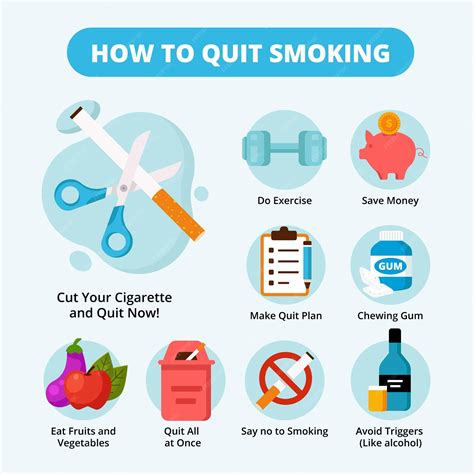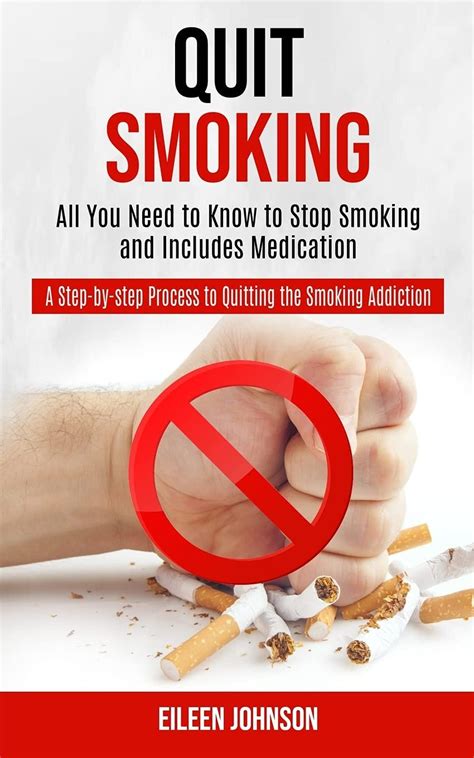Intro
Discover 5 effective ways to quit smoking, overcoming nicotine addiction with healthy alternatives, stress management, and support systems, for a smoke-free life.
Quitting smoking is one of the most challenging tasks a smoker can face, but it is also one of the most rewarding. Smoking is a leading cause of preventable death worldwide, and quitting can significantly reduce the risk of developing smoking-related illnesses such as heart disease, stroke, and lung cancer. Many smokers try to quit but struggle with the withdrawal symptoms and the psychological addiction to nicotine. However, with the right strategies and support, it is possible to overcome these challenges and live a healthier, smoke-free life.
The benefits of quitting smoking are numerous and well-documented. Within 20 minutes of quitting, heart rate and blood pressure drop, and within 12 hours, carbon monoxide levels in the blood return to normal. In the long term, quitting smoking can add years to a person's life and improve overall health and well-being. Despite these benefits, many smokers find it difficult to quit, and it often takes multiple attempts before they are successful. This is because nicotine is a highly addictive substance, and the psychological and physical dependence on it can be strong.
Smokers who want to quit often try various methods, including nicotine replacement therapy, prescription medications, and alternative therapies such as acupuncture and hypnosis. While these methods can be effective, they may not work for everyone, and it is often a combination of approaches that leads to success. Additionally, having a supportive network of family and friends, as well as a clear understanding of the reasons for quitting, can make a significant difference in the quitting journey. With the right mindset, strategies, and support, anyone can overcome the challenges of quitting smoking and start living a healthier, smoke-free life.
Understanding Nicotine Addiction

Factors Contributing to Nicotine Addiction
Several factors contribute to nicotine addiction, including the speed and efficiency of nicotine delivery, the frequency and amount of nicotine use, and individual differences in nicotine sensitivity and metabolism. Nicotine is quickly absorbed into the bloodstream when smoked, reaching the brain within seconds and producing a rapid and intense effect. This can create a strong psychological dependence on nicotine, as smokers associate the act of smoking with the pleasurable effects of nicotine. Additionally, individual differences in nicotine sensitivity and metabolism can affect how quickly and intensely nicotine is absorbed and processed, influencing the development of nicotine addiction.Strategies for Quitting Smoking

Nicotine Replacement Therapy
Nicotine replacement therapy is a popular quitting strategy that involves using products such as gum, lozenges, or patches to deliver nicotine to the body. These products come in various forms and strengths, allowing smokers to choose the one that best suits their needs. Nicotine gum and lozenges are fast-acting and can be used as needed to manage cravings, while nicotine patches provide a steady and consistent dose of nicotine throughout the day. Nicotine replacement therapy can be effective in reducing withdrawal symptoms and cravings, but it is often most effective when used in combination with other quitting strategies.Prescription Medications for Quitting Smoking

Alternative Therapies for Quitting Smoking
Alternative therapies such as acupuncture and hypnosis can help manage stress and cravings, making it easier for smokers to quit. Acupuncture involves the insertion of thin needles into specific points on the body, stimulating the release of chemicals that can help reduce cravings and withdrawal symptoms. Hypnosis involves the use of guided imagery and suggestion to help smokers manage stress and cravings, reducing the psychological dependence on nicotine. While these therapies may not be as well-studied as other quitting strategies, they can be effective in helping smokers quit, especially when used in combination with other approaches.Coping with Withdrawal Symptoms

Managing Stress and Cravings
Managing stress and cravings is crucial for quitting smoking, as these can trigger relapse. Engaging in stress-reducing activities such as meditation or yoga, avoiding triggers such as smoking-related cues, and using nicotine replacement therapy or prescription medications can help manage stress and cravings. Additionally, having a supportive network of family and friends can provide emotional support and encouragement, helping smokers stay on track with their quitting journey.Staying Smoke-Free

Avoiding Relapse
Avoiding relapse is crucial for staying smoke-free, as it can be challenging to quit again after relapsing. Identifying triggers such as smoking-related cues, avoiding high-risk situations, and using nicotine replacement therapy or prescription medications can help manage cravings and withdrawal symptoms, reducing the risk of relapse. Additionally, having a supportive network of family and friends can provide emotional support and encouragement, helping smokers stay on track with their quitting journey.What are the benefits of quitting smoking?
+Quitting smoking can reduce the risk of developing smoking-related illnesses such as heart disease, stroke, and lung cancer, and can improve overall health and well-being.
What are the most effective quitting strategies?
+The most effective quitting strategies often involve a combination of approaches, including nicotine replacement therapy, prescription medications, and alternative therapies such as acupuncture and hypnosis.
How can I manage withdrawal symptoms?
+Withdrawal symptoms can be managed by staying hydrated, avoiding triggers, and engaging in physical activity, as well as using nicotine replacement therapy or prescription medications.
If you're a smoker who wants to quit, remember that it's never too late to start your journey towards a healthier, smoke-free life. With the right strategies and support, you can overcome the challenges of quitting smoking and start enjoying the many benefits of being smoke-free. Don't be afraid to reach out for help, whether it's through a healthcare provider, a support group, or a trusted friend or family member. Stay committed, stay positive, and you'll be on your way to a smoke-free life in no time. Share your quitting story, ask for advice, or simply let us know what you think about this article in the comments below. Together, we can make a difference and create a healthier, smoke-free community.
